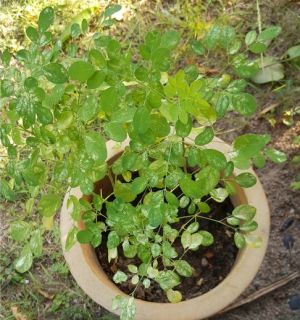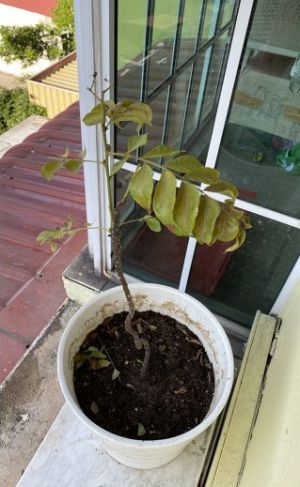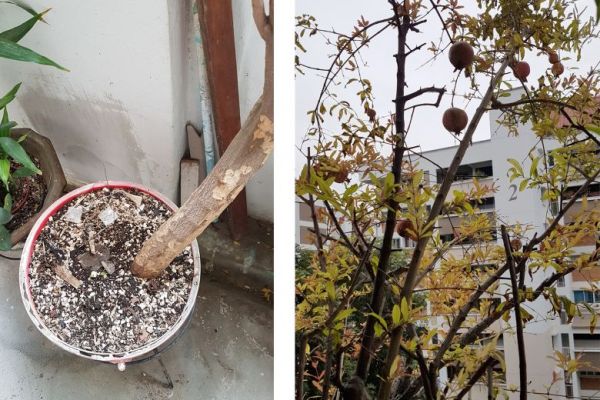Gardening FAQ #3 – What You Need To Know
Moringa plant may have spider mites

What is wrong with my moringa plant?
Your drumstick tree sapling may be infested with spider mites.
The yellow patches on the leaves are tell-tale signs of the damage they cause after they suck sap from the leaves. Spider mites appear as small red dots on the underside of leaves.
For food plants, you may want to spray a dilute solution of neem oil or summer oil during the cooler part of the day to kill the remaining adult mites on the plant.
When new leaves emerge, consider spraying the foliage regularly with water to wash off mites and to create a humid environment. Apply summer oil or neem oil solution on a regular basis to keep the pest population low.
For suggestions on how to control another plant worst enemy, head over to our section on Weed & Moss Control.
Curry plant may be lacking nutrients and sunlight
 I have been growing curry leaves for three years, but there are only a few stalks of leaves at any time. I have replanted it several times, increasing the pot size each instance. Lately, there has been no new stalk of leaves and the remaining branches of leaves are turning yellow. This is even though I have added fertiliser, which usually restores the plant.
I have been growing curry leaves for three years, but there are only a few stalks of leaves at any time. I have replanted it several times, increasing the pot size each instance. Lately, there has been no new stalk of leaves and the remaining branches of leaves are turning yellow. This is even though I have added fertiliser, which usually restores the plant.
The curry tree is a sun-loving plant and the lack of growth could be due to insufficient sunlight. For best results, it should be planted in a location where it can get at least six hours of direct sunlight. If that is not possible, you might want to consider getting a grow light fixture.
The yellow leaves and lack of robust growth could also be due to the lack of nutrients.
The soil in the pot appears to be quite compacted, which inhibits healthy root growth. If the plant has been growing in the same pot for a long time, nutrients in the soil may have been exhausted. You may want to move the plant to a slightly larger pot with fresh soil that is friable and well-drained.
Good-quality organic matter like mature compost can be added to help maintain a more open soil structure.
You can also read our post on Best Grow Bags: Honest Reviews + Buyer’s Guide for ways to improve this situation.
African Milkbush may be lacking light at lower part of the plant
 The upper part of this plant grows well, but the lower part is dropping branches. Why is this happening?
The upper part of this plant grows well, but the lower part is dropping branches. Why is this happening?
The plant is botanically known as Euphorbia tirucalli. Its common names include African Milkbush, Pencil Cactus and Milk Bush. It is a drought-tolerant, sunloving plant that needs to get at least six hours of direct sunlight to grow well.
Are all parts of your plant exposed to direct sunlight? The loss of lower branches may be a sign the affected parts are not receiving the sunlight they require. Also, do not overwater.
The sap of this plant is highly toxic. It can cause blindness and severe skin irritation, so handle the plant with care.
An alternative you can consider is to shift them indoor and nucture them under grow lights until the heavy rain seasons are over. For more details, check out our post on Best Growing Light Fixtures And Buyer’s Guide.
Pomegranate plant may be rootbound and lack nutrients

I have had this pomegranate plant for more than 30 years. The leaves do not look healthy, but the plant bears quite a number of fruit. These are, however, small and not edible. How do I nurture the plant back to health?
Your pomegranate plant may be lacking nutrients, judging from its yellow leaves. The growing pot appears to be too small for the plant.
How long has the plant been growing in it?
If the plant has been growing in the same pot for a long time, its roots could have filled the space and nutrients in the soil could have been exhausted. The soil properties could have changed as well.
You may want to move the plant into a larger pot with fresh media. You can also read our post on Best Grow Bags: Honest Reviews + Buyer’s Guide for ways to improve this situation.
Check the health of the roots when you are moving the plant. Untangle circling roots and cut away dead ones. There is no need to remove the old soil. Fertilise your plant when it starts to show new growth.